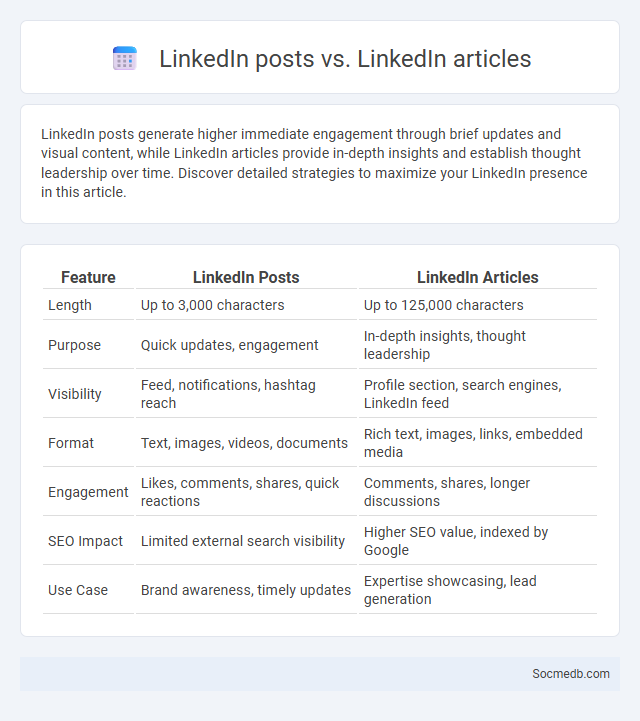
Photo illustration: LinkedIn posts vs LinkedIn articles
LinkedIn posts generate higher immediate engagement through brief updates and visual content, while LinkedIn articles provide in-depth insights and establish thought leadership over time. Discover detailed strategies to maximize your LinkedIn presence in this article.
Table of Comparison
| Feature | LinkedIn Posts | LinkedIn Articles |
|---|---|---|
| Length | Up to 3,000 characters | Up to 125,000 characters |
| Purpose | Quick updates, engagement | In-depth insights, thought leadership |
| Visibility | Feed, notifications, hashtag reach | Profile section, search engines, LinkedIn feed |
| Format | Text, images, videos, documents | Rich text, images, links, embedded media |
| Engagement | Likes, comments, shares, quick reactions | Comments, shares, longer discussions |
| SEO Impact | Limited external search visibility | Higher SEO value, indexed by Google |
| Use Case | Brand awareness, timely updates | Expertise showcasing, lead generation |
Understanding LinkedIn Posts: Features and Benefits
LinkedIn posts offer a unique platform for professionals to share insights, industry news, and career achievements, enhancing personal branding and networking opportunities. Features such as rich media attachments, hashtags, and tagging increase engagement and visibility within targeted professional communities. Leveraging LinkedIn's algorithm through consistent, relevant content helps amplify reach, fostering meaningful connections and business growth.
Exploring LinkedIn Articles: Purpose and Advantages
LinkedIn articles serve as a strategic tool for professionals to showcase expertise and thought leadership within their industry, enhancing personal and brand credibility. These articles improve visibility by appearing in users' feeds and can attract targeted connections, potential clients, or recruiters seeking in-depth insights. The platform's algorithm favors original, well-written content, increasing the chance of engagement and expanding professional networks through meaningful discussions.
Key Differences Between LinkedIn Posts and Articles
LinkedIn posts are brief, engaging updates designed for quick consumption and immediate interaction, making them ideal for sharing timely insights or personal achievements. Articles on LinkedIn offer in-depth, long-form content that establishes thought leadership and provides comprehensive information on industry trends or professional expertise. Understanding these key differences helps you tailor your content strategy to maximize engagement and professional impact on the platform.
Audience Engagement: Posts vs Articles
Audience engagement on social media varies significantly between posts and articles, with posts typically generating higher interaction rates due to their concise format and visual appeal. Short, visually-driven posts encourage likes, comments, and shares more effectively than longer articles, which demand greater time investment and may attract a more dedicated, niche audience. Optimizing post content with targeted keywords, hashtags, and interactive elements such as polls or questions boosts overall engagement metrics and fosters community interaction.
Content Longevity: Which Performs Better?
Content longevity varies significantly across social media platforms, with evergreen posts on platforms like Pinterest and YouTube performing better in maintaining engagement over time compared to ephemeral content on Snapchat and Instagram Stories. Videos and informative posts tend to generate sustained traffic and interactions, extending their relevance beyond initial publication. Your strategy should prioritize creating timeless, value-rich content to maximize long-term visibility and audience retention.
When to Use LinkedIn Posts in Your Strategy
LinkedIn posts should be used in your strategy when targeting professionals, industry leaders, and B2B audiences, as the platform excels in fostering business-related content and networking. Sharing insightful articles, company updates, and professional achievements during weekdays, especially mornings and early afternoons, maximizes engagement. Utilize LinkedIn posts to build your personal brand, establish thought leadership, and generate qualified leads by aligning content with your audience's interests and professional needs.
When to Publish LinkedIn Articles for Maximum Impact
Publishing LinkedIn articles during peak engagement times, typically midweek between Tuesday and Thursday from 8 a.m. to 2 p.m., maximizes visibility and reader interaction. Analyzing LinkedIn analytics reveals that posts made in the early morning and lunchtime hours often see higher click-through rates and shares. Scheduling content to align with professional users' active hours ensures greater reach and amplifies the article's impact within targeted industry networks.
Integrating Posts and Articles Into Your Content Strategy
Integrating posts and articles into your social media content strategy enhances audience engagement by providing a mix of short-form updates and in-depth insights. Consistent posting of well-researched articles alongside timely social media posts boosts brand authority and drives organic traffic to your platforms. Leveraging analytics tools to track the performance of both formats helps refine content distribution for maximum reach and impact.
Analytics and Performance Metrics: Measuring Success
Social media analytics provide crucial insights into your audience's behavior, engagement rates, and content reach, allowing you to optimize your strategy effectively. Key performance metrics such as click-through rates, conversion rates, and follower growth help quantify the success of your campaigns and identify areas for improvement. Leveraging real-time data and advanced analytics tools empowers you to make informed decisions to maximize your social media impact.
Best Practices for a Winning LinkedIn Content Strategy
Developing a winning LinkedIn content strategy requires consistently sharing industry-relevant insights that engage your target audience and showcase your expertise. Leveraging LinkedIn's analytics tools helps identify top-performing content, enabling data-driven adjustments to enhance reach and engagement. Incorporating a mix of original articles, thought leadership posts, and interactive content such as polls or videos boosts visibility and fosters meaningful professional connections.
 socmedb.com
socmedb.com